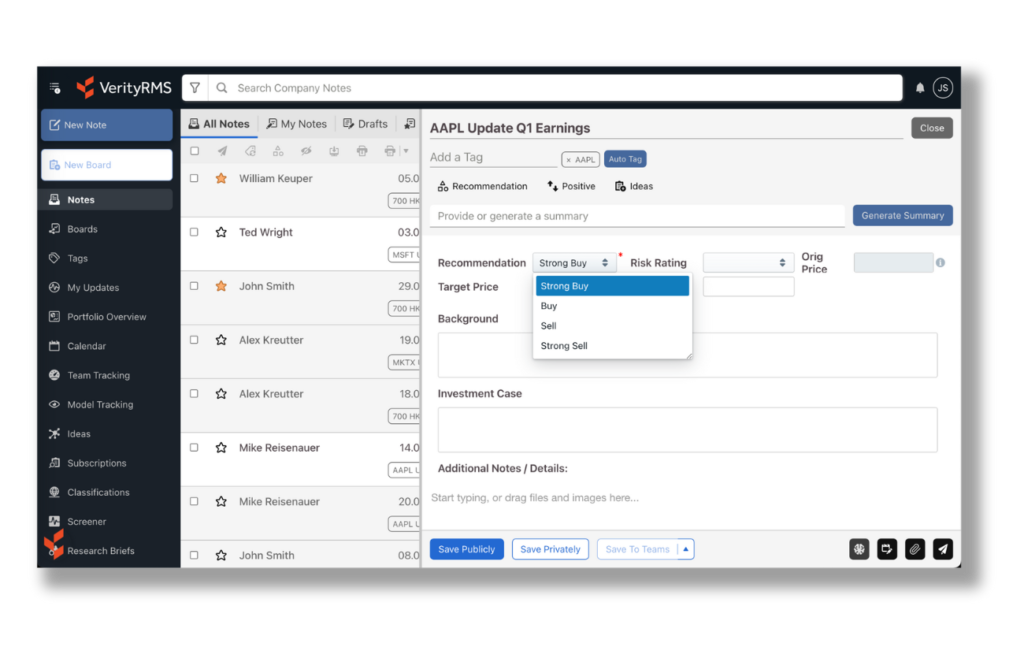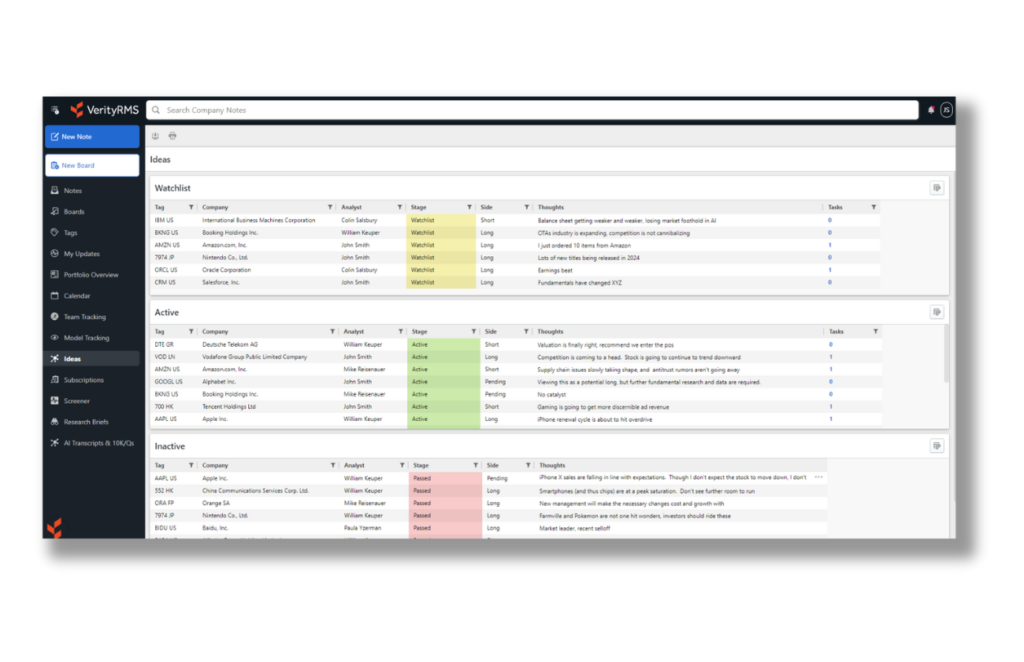
September 27, 2024
Thinking About Migrating to a Modern RMS? Lessons From 100+ Migrations
Discover why and how 100s of firms have successfully migrated to VerityRMS.
So, you’re thinking about upgrading your RMS but concerned about what migration looks like? You’re not alone. It can feel like a high-stakes proposition. The research team can’t be interrupted during the process, and you want to make sure that when they login to the new RMS that they don’t miss a step.
The truth is firms can take one of many paths before adopting a system like VerityRMS. Maybe your RMS provider has gone into legacy maintenance mode or has been acquired, and you aren’t happy with the new platform post-acquisition. Maybe your team is outgrowing shared drives & email or even lightweight notebook systems.
In this blog, we share why firms migrate to VerityRMS, how our team handles historical research migrations, and share important considerations for firms that want to prepare for the transition.
Why Are Firms Migrating to VerityRMS?
Firms switch to VerityRMS for several common reasons.
Fear of Missing Important Developments: Big market movers are easy to spot, but gradual shifts can be overlooked without the right process. VerityRMS improves efficiency and highlights slow capital erosion or increasing conviction that might otherwise be missed.
Learn more >
Data Underutilization: Portfolio managers must make timely decisions by correlating internal and external data. VerityRMS ensures costly data is properly utilized by the right people, at the right time, and in the right context.
Learn More >
Lack of Insights on Missed Opportunities: Learning from wins and losses is easy, but what about missed ideas? VerityRMS provides actionable insights, helping teams improve by analyzing unacted opportunities.
Learn More >
Disruptive Compliance: Juggling compliance and PM duties? VerityRMS reduces the burden. Or, if there’s a dedicated team, it streamlines the compliance process without disrupting the investment team.
Learn More >
Knowledge Loss & Long Onboarding Runways: When analysts leave, their knowledge often goes with them. VerityRMS stores their research, making it easier for new analysts to quickly contribute.
Learn More >
Inefficient Processes & Clunky Workflows: Funds often use multiple tools for research, resulting in inefficiency. VerityRMS brings cohesion to investment research workflows, speeding up decision-making.
Learn More >
Time Lost to Report Generation: Generating reports and audit trails is tedious when data is scattered. VerityRMS centralizes information, allowing users to create reports with a single click.
Existing System Not Scaling With You: Sometimes a legacy research management system doesn’t offer the customization abilities or data insight tools you need today. With VerityRMS, you can fine-tune to your firm’s needs and, with a data agnostic model, pipe in and aggregate the data insights you need.
Considerations for a Smooth Migration
Our team has completed over 100 successful migrations from a wide range of providers, including legacy vendors, lightweight systems, and custom-built solutions. Through these experiences, we’ve identified several key considerations that help ensure a smooth transition to VerityRMS.
We know that switching systems can be daunting, but our goal is to remove any uncertainty and make the process as seamless as possible. Says Felix Fenn-Evans, one of our senior implementation specialists, “Our goal is to make it as easy as possible.”
How Organized Is Your Research Currently? How Happy Are You With It?
One of the first questions we ask customers is: How organized is your current data structure? If you’re migrating from another RMS, chances are you already have a relatively structured system that can be mirrored or improved in VerityRMS.
However, if you’re coming from a less formal or manual solution (e.g., spreadsheets, cloud storage, or ad-hoc notes), there may be some upfront work required to get your content into a more manageable format. Taking the time to assess the organization of your current data will help streamline the migration and set your team up for success with VerityRMS.
Using shared drives? “Something as simple as organizing your notes by company names or tickers can expedite the migration process significantly,” says Fenn-Evans.
How Much Legacy Content Do You Need to Bring Over?
Many firms initially think, “Let’s bring everything we have into the new RMS.” While it might seem logical to carry over all past research — and sometimes it is the right choice — we encourage customers to carefully consider how much legacy content is truly necessary. Ask yourself: Is everything from the past decade still relevant to your current investment process?
Often, focusing on the most recent and frequently used data—such as research from the last two years or content still actively being referenced—can make the migration more efficient and help users start fresh in the new system.
“What historical content is part of your investment process? Is that email from 2012 still relevant?” says Lauren Sylvetsky, VP, Customer Success. Streamlining your content to focus on what matters most can not only speed up the migration but also enhance the overall user experience in the new RMS.
How Do We Speak the Same Language?
One critical aspect of a successful migration is ensuring that data fields, categories, and terms from your current system map seamlessly into VerityRMS. “Different systems may use different terminology or organizational structures, so we work closely with your team to translate your existing data into a format that makes sense for your users,” says Fenn-Evans.
This includes determining how fields in your old system will be represented in VerityRMS. Our team spends a significant amount of time on this step to ensure your data is organized in a way that preserves continuity and usability.
What Do Different Stakeholders Need from the System?
A successful migration goes beyond data. It’s crucial to understand the unique needs of all stakeholders who will be using the RMS. For example, portfolio managers may prioritize certain types of research or reports and are looking to collect specific data from analysts. Analysts might need note authoring templates that make it easy to capture essential data within their existing processes. For larger asset managers, different teams may have different workflows, and accommodating these workflows within the new system is key to maximizing its value.
Early in the migration process, we work to identify the requirements of various teams, such as the type of content they interact with and the user experience they expect. “What’s your process, and how do different roles within the firm interact with the system?” Fenn-Evans explains. Having this holistic view ensures that the RMS is configured to meet the needs of all stakeholders, right from the start.
What Dashboards, Workflows, & Note Templates Do You Want for Launch?
The dashboards, workflows, and note templates you start with in VerityRMS will play an important role in user adoption and overall system usability.
During migration, you have the opportunity to redesign or streamline your templates to better fit the current needs of your team. This can include everything from how research notes are formatted to how meetings are logged in the system.
Starting with the right dashboards & note templates can make the transition smoother and give users a system that feels intuitive and tailored to their workflow.
Workflows can be another important consideration. What processes would you like to standardize and automate? Understanding what you want from your workflows can help drive decisions around what gets included in dashboards and note templates.
What Other Systems Should Be Accounted For?
Another important consideration is how your RMS interacts with downstream and upstream systems. Are you primarily focused on research and content related to a single public company? Or do you need to account for more complex hierarchies involving fixed income-driven products, securities, or even private investments?
“For firms with broader, multi-asset strategies, your RMS can integrate with other systems and make sure everything is connected in one place,” says Pavel Zaletaev, Verity Head of Solutions Engineering.
Without the right RMS in place, it becomes difficult to track these connections and maintain an accurate picture of how each investment is performing relative to others in its hierarchy.
How It Works With VerityRMS
Migrating to a new system can often feel overwhelming, but with VerityRMS, we aim to make the process as painless and seamless as possible. Our proven seven-step process ensures that your team remains productive throughout the migration, with no interruptions to your research workflow.
When transitioning to VerityRMS, you can expect your investment teams to continue working without disruption. Our migration process is designed to run smoothly in the background, coordinated with your internal technology teams, so that once the migration is complete, your team is ready to hit the ground running on day one.
Our Seven-Step Migration Process
At VerityRMS, we’ve migrated firms from all types of systems, including legacy RMS platforms, modern tools, DIY solutions, and even disparate third-party tools such as Microsoft Office and shared drives. Whether your firm has decades of research or just a few years of data, we handle migrations of all sizes with the same level of care and expertise.
Here’s how we ensure a seamless transition:
- Scope
We meet with your team to determine the scope, timelines, and deliverables that will be included in your migration. We’ll begin prioritizing workflows, dashboards, and note templates. - Transfer
We securely receive or transfer your data, following your firm’s policies. This step involves transferring the data to a secure location, ensuring compliance with security protocols. We’ll also continue refining dashboards, templates, and workflows. - Validate & Import
Together, we perform integrity checks, including MD5, file, and crosschecks, to validate the data. At this stage, we create notes, tags, and attach files, ensuring your data is structured as needed. - Format Content
Ensuring that all content, styling, and properties are tailored to end user, we address any shortcomings from the legacy system to improve data usability in VerityRMS. - Customer Review
You’ll have the opportunity to review the migration hierarchy to ensure everything meets your expectations before finalizing the move. - Finalize & Handoff
Once you approve the migration, we finalize the process and hand over the system, ready for immediate use.
Maximum Coverage
We steer your migration process from start to finish. All we need from you is a simple communication to your current provider or internal teams to initiate the data transfer. From there, our experienced team handles every step of the process, ensuring that your migration is completed without any hassle.
By the time we hand off the system, your team will be fully equipped to take full advantage of the VerityRMS platform, ensuring that your research management processes are optimized from day one.
Bottom Line
Regardless of why, the Verity team is ready to provide best practice advice to help new customers get the most value from VerityRMS based on your firm’s unique data model requirements and workflows. The Verity team is also ready to manage the successful migration of existing research assets and data efficiently and effectively, as we’ve done over 100 times before.
See How Firms Are Scaling & Streamlining Investment Research
At Verity, we offer the modern research management system trusted by global asset managers. Request your custom demo to explore the possibilities VerityRMS can bring to your process, workflows, and decision-making.




Outperformance Starts Here
See how Verity accelerates winning investment decisions for the world's leading asset managers.
Request a Demo

